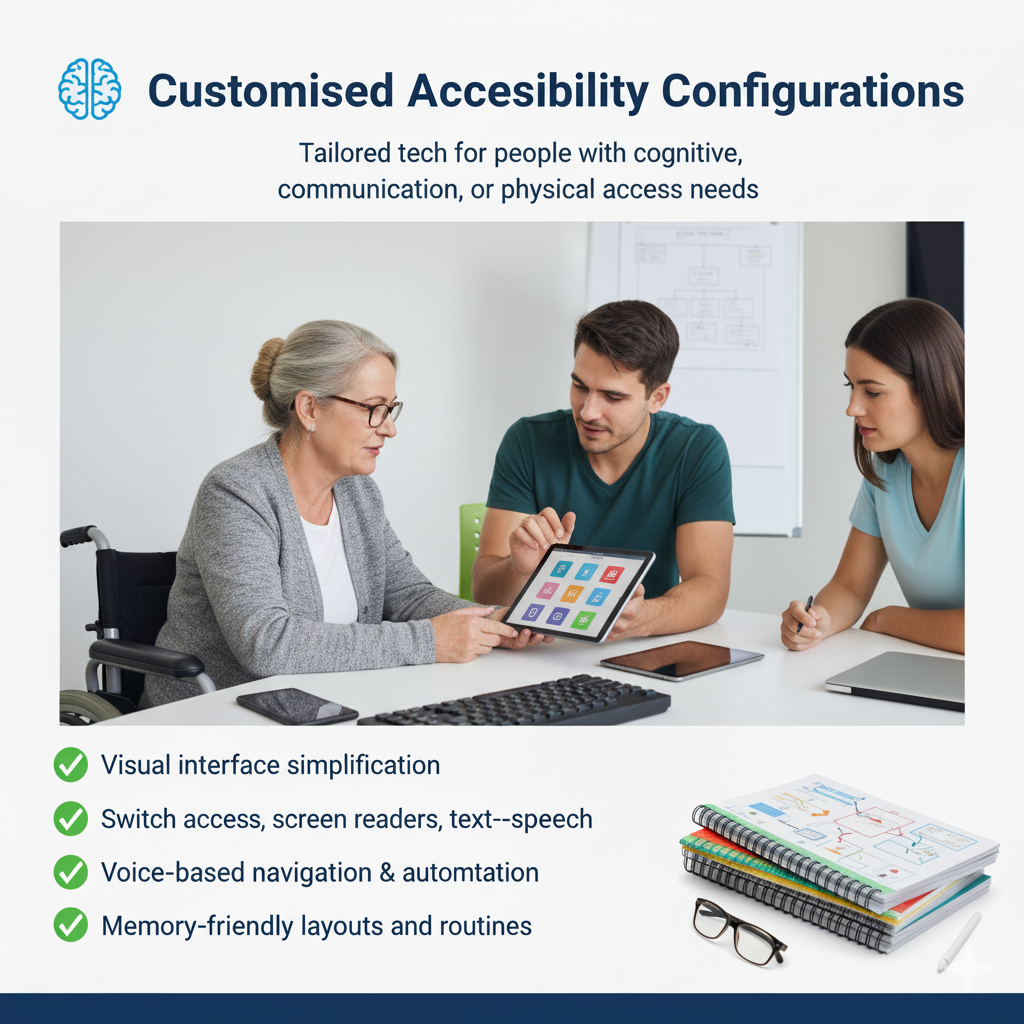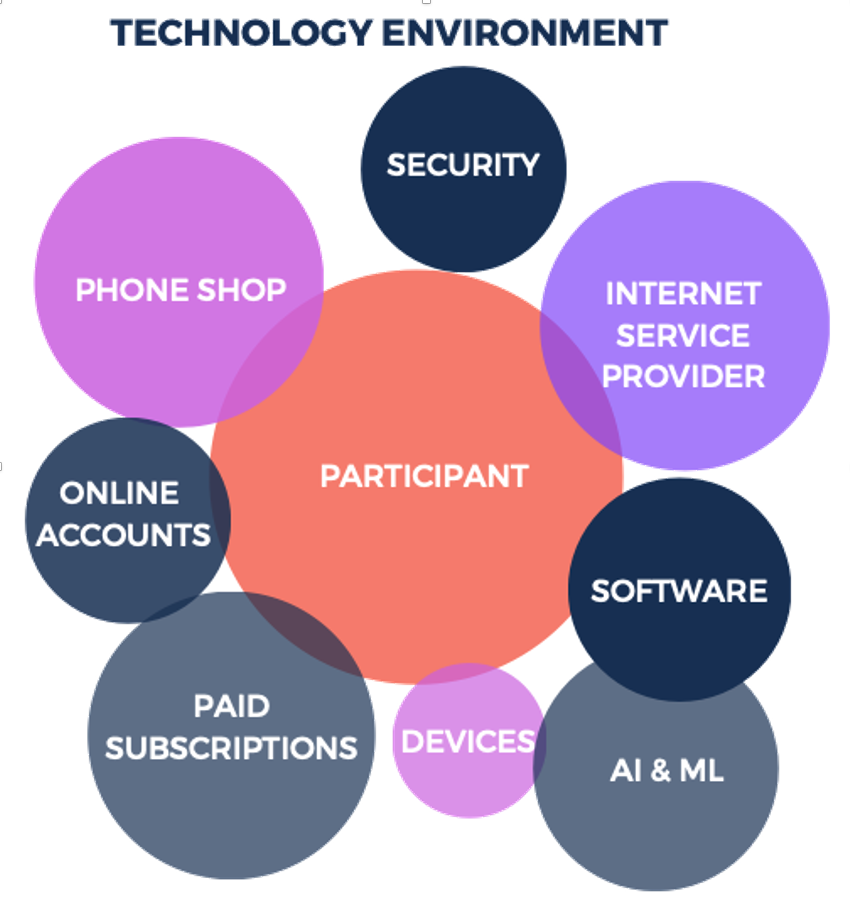Create a stable, voice-activated home environment that boosts independence and reduces stress for carers. Tailored tech solutions for people with special needs — book a free consultation today.
Communication Discussion of Assisting Carers. Ideas and Services. Creating Independence, Reduce Risk and Lift Supports
Accept My Free eBook Below
...
Accept My Free eBook Below ...
“Living Without Limits: AI Technologies for Disability Support”
Who is this ebook for?
This book is designed for individuals with disabilities, caregivers, and professionals who want to harness the power of AI and smart technology to improve independence, safety, and quality of life. It is particularly valuable for people with cognitive impairments, motion impairments, and sensory disabilities who can benefit from customized technological solutions.
Highest Benefit - Specific Disabilities:
•Cognitive Disabilities (e.g., Autism, Traumatic Brain Injury, Dementia, Intellectual Disability): AI-powered reminders, virtual assistants, and smart home automation can support memory, daily routines, and independence.
•Motion Impairments (e.g., Paraplegia, Quadriplegia, Cerebral Palsy, Stroke Recovery): Smart home controls, voice-activated devices, and AI-driven mobility assistance can enhance daily living.
•Sensory Disabilities (e.g., Blindness, Low Vision, Hearing Impairments): Screen readers, AI-powered voice-to-text, and smart hearing assistance can improve accessibility and communication.
How Carers & Support Workers Can Use This Book:
•Personalised Technology Planning: Learn how to select and implement AI tools that match the needs of the person they support.
•Training & Support: Gain insights on coaching individuals to use smart devices effectively, reducing dependency on human assistance.
•Long-Term Cost Reduction: Discover how to leverage AI without falling into expensive subscription traps, ensuring sustainable solutions.
•Building Independence: Learn strategies for integrating AI to foster more autonomy while ensuring safety and connectivity.
Why This Book Stands Out:
•Practical Implementation: Not just theory—this book provides real-life examples of AI improving accessibility.
•Tech Made Simple: Breaks down complex concepts into clear, easy-to-understand solutions.
•Future-Proofing Disability Support: Explores cutting-edge AI innovations and how they can evolve with user needs.
🔹 Ideal for: Disability service providers, support workers, carers, families, and anyone interested in leveraging technology for greater independence and inclusion.
In just 60 seconds, by choosing and downloading a book, you’ll:
Get a clear starting point for understanding Ecothesis—my framework for configuring customised home communication systems
See how everyday tech can be orchestrated to support someone’s specific needs, not just sit unused in a drawer
Learn the first steps to reduce overwhelm for carers while increasing independence hours for the person they support
Discover why most setups fail (even with the “right” devices) and how to avoid those mistakes
Explore practical examples of how phones, tablets, and smart devices can be tailored to real-life challenges like mobility, cognition, or memory
Understand the simple process that turns scattered tech into a reliable daily routine tool
Finally, have a way to approach technology that feels doable—even if troubleshooting settings usually drives you up the wall
Hi, I’m Allen!
I’m a Personal Communications Specialist, author, and creator of systems that make technology simple and sustainable (ask me about the first time I turned an ordinary smart speaker into a daily independence tool for someone who’d given up on tech altogether).
Back in the 1990s, I started solving everyday computer and network problems for small businesses and families. Over time, I saw a pattern: people weren’t failing with technology because they lacked devices—they were failing because no one translated the setup into something that actually worked for them.
By the mid-2010s, I became obsessed with bridging that gap. I studied how people with cognitive, physical, and emotional challenges interacted with technology. It wasn’t about gadgets—it was about independence, confidence, and calm. So I built a framework: assess → configure → document → onboard → support.
Now my focus is global. I package these methods into books, courses, and digital toolkits that show carers, support workers, and professionals how to make everyday tech deliver real outcomes. From configuring phones and tablets to orchestrating smart homes, I share practical steps that save time, reduce stress, and increase independence hours.
Through years of fieldwork and publishing, I’ve developed a proven approach anyone can apply—whether you’re a parent, a professional, or a service provider. My goal is simple: make technology work for people, not against them, and scale that knowledge so millions can benefit.
Configured Communications
-

Carer & Support Team Training
Equip carers and support staff with the tools and confidence to support everyday tech.
-

Customised Accessibility Configurations
Tailored tech for people with cognitive, communication, or physical access needs.
-

App & Account Access Support
Unlock essential apps and services with secure, simplified logins and configurations.
The truth is, in 2025 without the right technology systems in place, you’re missing out on a powerful way to create independence, reduce stress, and free up time.
And poorly set-up technology can lead to:
Clients depending on carers for tasks they could do themselves
Wasted hours troubleshooting devices that never seem to “just work”
Lost confidence and frustration for both carers and clients
Feeling stuck in cycles of crisis instead of calm daily routines
Because if your technology isn’t giving you independence, it’s probably taking it away.
Pre-Configuration: The Foundation Before Digital Literacy
Before anyone can learn digital skills, their device must simply work.
Pre-configuration removes the technical friction so participants can focus on learning—not troubleshooting.
Purpose
Eliminate setup complexity
Standardize device environments
Ensure security and accessibility from day one
Enable immediate access to government and essential services
Core Pre-Configuration Actions - Orchestration to Outcomes
Area Action Device Readiness Select compatible hardware (e.g., Android tablet with current OS). Apply updates. Enable accessibility features such as voice control, large icons, and simplified home screens. Connectivity Configure stable Wi-Fi, mobile data fallback, and auto-reconnect. Test reliability in the participant’s environment. Accounts and Identity Conflict reduction, Create or verify a single digital identity (e.g., myGov). Use secure, memorable credentials. Record recovery methods. Prevent multiple fragmented accounts. App Installation Install only essential apps—government, health, communication, and accessibility. Lock or restrict Play Store to avoid accidental clutter. Security and Privacy Enable PIN or biometric lock. Turn on automatic updates. Configure backups and remote-device location. Navigation Simplification Remove bloatware. Pin critical apps to the home screen. Use text replacements or shortcuts for common input. Assistive Layer Set up default PDF reader, text-to-speech, and augmentative communication tools. Pre-train voice assistants for accurate recognition. Documentation Supply a “Start Here” guide with screenshots, passwords (securely stored), and support contact details—digital or printed.
Outcome
Once pre-configuration is complete, every participant begins their digital literacy journey on a stable, predictable device.
Trainers can teach real skills—navigating government portals, managing online identity, using communication tools—without wasting time solving tech problems.
This foundation step is vital for health participants and people with cognitive or motor challenges, removing overwhelm and building early confidence in technology.
Configured to Capacity means every device and system is set up to its full potential—secure, accessible, and ready for learning. When participants start from a stable, predictable environment, their digital literacy training becomes focused on capability, not repair. This foundation allows genuine skills development to occur—confidence grows as technology responds consistently, and participants can move from simple daily tasks to advanced independence. A well-configured environment transforms frustration into progress, enabling both learners and support workers to build sustainable digital capability.



